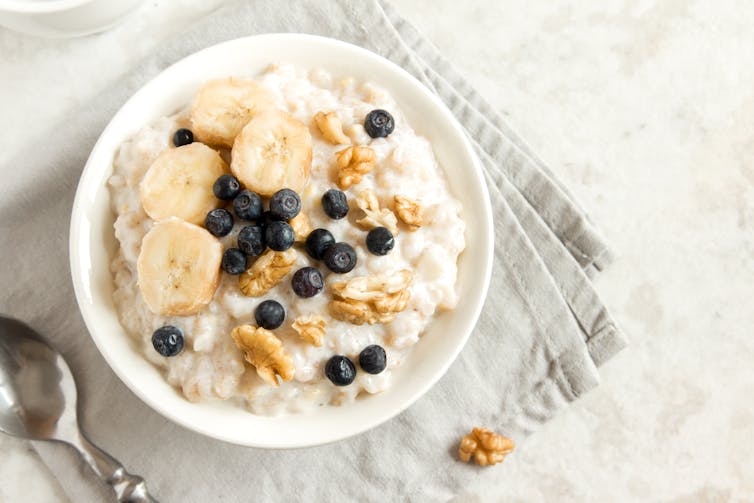Written by Evangeline Mantzioris, University of South Australia
The cereal bowl is sitting there getting mushy and gross. You ask your child to eat for the 20th time, but still they sit there, totally unwilling.
Eventually, there is simply no time left (the school bell will ring in three minutes) and you have to make a hasty exit out of the house. Maybe your child has eaten one or two mouthfuls, maybe they have had nothing. You and your kid are both cranky and stressed.
Does this sound familiar?
Unfortunately, eating breakfast really is important. So as parents, you do need to offer it and do need to try and make sure it is eaten.
But as a dietitian and a mum, I can assure you, it can be easier than this! How can parents get their kids to eat this important meal, without making it the most irritating part of the day?
How many kids skip breakfast?
Research tells us a lot of children don’t eat breakfast.
The most recent data we have is about ten years old. But as of 2011–12, close to 12% of boys and 15% of girls aged between two and 17 skip breakfast.
This increases with age. By the time children are 14 to 17, about 25% of boys and 36% of girls miss the meal. These results are somewhat similar to reported rates of breakfast-skipping around the world.
How important is the first meal of the day?
You have heard it before and that’s because breakfast really is important.
As research shows, skipping breakfast has been associated with lower diet quality.
For example, 2018 US research on children aged two to 12 who skipped breakfast on the day of study found 36% of their daily energy intake came from snacks compared to 29% in those who ate breakfast.
Breakfast skippers also had lower intakes of fibre, folate, Vitamin A, iron and calcium – all critical nutrients for physical and mental growth and development in children – than kids who did eat breakfast. Their intake of processed and ultra-processed foods was also higher.

www.shutterstock.com
A review of 16 studies in children and adolescents also indicates skipping breakfast in this age group is linked with more risk of obesity and being overweight. And this can lead to an increased risk of type 2 diabetes in children.
A study which looked at breakfast consumption in children and then followed them into adulthood found if they continued to skip breakfast they had higher risk of detrimental effects on their heart health and diseases such as metabolic syndrome and diabetes.
It is also important for learning
Skipping breakfast means there is not enough glucose in the body (from breaking down carbohydrates), which is what the brain prefers as its energy source. Glucose provides the energy for messaging between the brain cells and helps to make neurotransmitterss (chemical messages in the body).
Studies also show children who eat breakfast regularly perform better academically than those who skip it. In particular, skipping breakfast impacts on their memory and the number of errors on attention tasks.
This effect on achievement is more pronounced for those children who don’t eat enough nutritious food overall. Interestingly school breakfast programs lead to improvements in academic ability, but it is thought this may be because children attend school more.
Why don’t kids want to eat breakfast?
A 2014 study conducted in Australia and England tried to identify why adolescents skip breakfast. This found teenagers said they did not have time, were not hungry or did not enjoy breakfast. Only a small percentage reported skipping breakfast to control weight.
A 2019 study in the United States of kids aged six to 11 asked both parents and children why they think children skip breakfast.

www.shutterstock.com
Respondents said lack of time and feeling rushed was the main reason.
In this study, they were also asked to identify what may help. Children suggested having a set morning routine and also selecting breakfast foods ahead of time.
The children also said that parents needed to continue to encourage them to eat breakfast. Parents were in agreement with these suggestions from the children but also said using “grab-and-go” products would also help.
Parents also said avoiding distractions – like books and phones – was important.
What can parents do?
1. Allow enough time
This will come as no surprise to parents, but we need to make sure kids have enough time to eat. This means getting up early enough and having a routine in the morning that makes time for breakfast.
2. Be prepared
To save time and make it easier set the breakfast table the night before. Get it ready with crockery, cups and cutlery, and put out the foods that won’t spoil overnight such as their favourite wholegrain cereal, spreads for toast and wholegrain bread.
3. Have a decent selection
Give your kids good options and make them feel like they have a choice. Ensure you have a range of healthy and easy breakfast options that your children like.
This can be traditional breakfast options like wholegrain breads and breakfast cereals, fruit toast, yoghurt and cut up or frozen fruit. Porridge, particularly in winter, is great as it can cook itself in the microwave.
Offering smoothies with fruit, yoghurt, milk and oats may be appealing to adolescents.
4. Think outside the (cereal) box
There are no rules around what sort of healthy foods can be eaten at breakfast. The important thing is that they are from the Australian Dietary Guidelines.
Some may find healthy leftovers from dinner appealing or even a sandwich with avocado and salad fillings, or cold meats like chicken or tuna. Of course a cooked breakfast with wholegrain toast, eggs and veggies (avocado, mushrooms, tomatoes, spinach) is excellent, but this is not a quick option!
5. Get rid of distractions
Make sure your kids can just focus on eating. This means no TVs, devices, toys or books.
6. Do it yourself
Remember children are great imitators. So, if they see parents eating breakfast they are more likely to do it as well.
7. Have a back-up
If these ideas still don’t work and you have had one of those mornings where nothing goes right, then you could consider grab-and-go options.
These don’t have to be commercial products either – think of smoothies, toast, previously homemade savoury muffins or banana bread (that are perhaps stored in the freezer for these occasions) or a piece of fruit.
8. But be careful about muesli bars
Muesli bars can be an option, but make sure you look for ones that are low in sugar (less than 15 grams per 100 grams), low in saturated fat (less than 1.5 grams per 100 grams) and high in fibre (more than four grams per 100 grams). Remember if the bars contain fruit and nuts in them, the level of sugar and fat will go up, but this is not problematic as it is not added sugar or fat.
So, set yourself and you children up for successful breakfasts, and who knows? You may even enjoy the family eating together.![]()
Evangeline Mantzioris, Program Director of Nutrition and Food Sciences, Accredited Practising Dietitian, University of South Australia
This article is republished from The Conversation under a Creative Commons license. Read the original article.



Recent Comments